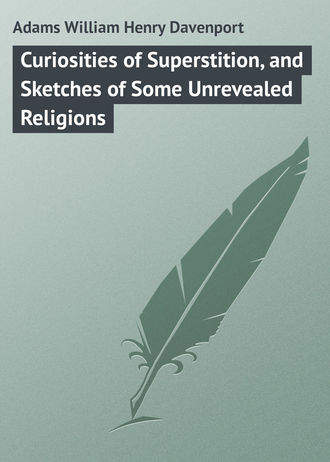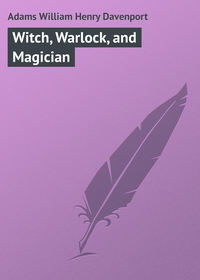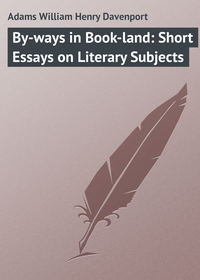 полная версия
полная версияCuriosities of Superstition, and Sketches of Some Unrevealed Religions
Fairies generally dwelt in subterraneous abodes; in the interiors of grassy hillocks, whence issued dulcet sounds and flashes of weird light; sometimes the side of a hill opened, and exposed them to the gaze of the belated wayfarer. No doubt they were seen everywhere by the potent gaze of imagination; on the meads and in the groves, or curled up among the bending flowers; for
“Visions as poetic eyes avow,
Hang from each leaf, and cling to every bough.”
They were reputed to be well skilled in the medical art, and to favoured mortals they sometimes imparted their knowledge. It is difficult to understand why they were credited with the abstraction of children, and with the substitution of other beings in their place. For this curious kind of theft was commonly attributed to them. A “wise woman” – a dealer in simples and herbal potions – having failed to cure a child, declared that “the bairn had been taken away, and an elf substituted.”
Besides the fairies, Scotland could boast of its spirits of the waters, just as Germany had its Loreleys and Ondines.
We can gather, however, no definite information respecting the water-kelpie, the water-horses, or the water-bull, or of another anomalous animal called shelly-coat. Describing Lochlomond, Graham says: – “It is reported by the countrymen living thereabouts, that they sometimes see the hippopotam or water-horse, where the river Cudrie falls into it, a mile west of the church of Buchanan.” A river known as the Ugly Burn, in the county of Ross, springing from Loch Glaish, was regarded with awe by all the countryside, as the retreat of the water-horse and other spiritual beings. Shetland is represented as having possessed a handsome water-horse which, when mounted, carried the rider into the sea. Mr. Dalyell, writing in 1835, says, that the water-bull is still believed to reside in Loch Awe and Loch Rannoch, nor, he adds, are witnesses wanting to bear testimony to the fact. It was reputed to be invulnerable against all except silver shot; though no one had put it to the proof. In the Isle of Man certain persons who saw the water-bull in a field were unable to distinguish him from one of the ordinary terrestrial species, nor did the cows show any disposition to avoid him. But his progeny always turned out to be a rude lump of flesh and skin, without bones.
The spirit of the sea was believed to be malicious, and capable of inflicting injury. Allusions are frequent to “sea-trowis, meermen, meermaids, and a number of little creatures coming from the sea” in response to spell and charm. Nor must we forget the practice of pouring out libations to the aquatic divinities. A century ago, in Crawford Muir, when a tenant was evicted and another took his place, he cut the throat of a black lamb and threw it into a stream, with a malediction both upon stream and lamb.
To this futile department of human error we can, however, devote no more space. To treat it adequately we should need at least a couple of volumes as closely printed as the present.
1
Miss Gordon Cumming, “From the Hebrides to the Himalayas,” ii. 226, 227.
2
Max Müller, Buddhism and Buddhist Pilgrims, pp. 5, 6.
3
Rig-Veda, i. 164, 46.
4
Rig-Veda, x. 121, by Max Müller.
5
The thought in this paragraph, and several of the expressions, are from Max Müller.
6
So in Shelley’s lyrical drama of “Prometheus Unbound:” —
7
Max Müller, pp. 13, 14.
8
Professor Wilson propounded a theory to the effect that there never was any such man as Buddha, but the theory has found few supporters.
9
The name “Sakya” is made into “Sakya-muni,” —muni in Sanskrit meaning “solitary,” (Greek, μόνος,) alluding to his solitary habits; and to Gautama is often prefixed “Sramana,” or “ascetic.”
10
Max Müller, pp. 14, 15.
11
Max Müller, pp. 15, 16, 17.
12
The following sketch is founded on M. Stanislas Julien’s “Voyages des Pélerins Buddhistes,” and on Max Müller’s review of that valuable work.
13
Max Müller, p. 36.
14
Voyages des Pélerins Bouddhistes. Vol. I. Histoire de la Vie de Hiouen-thsang, et ses Voyages dans l’Inde, depuis l’an 629 jusqu’en 645, par Hoeï-li et Yen-thsong; traduite du Chinois par Stanislas Julien.
15
Hoeï-li terminates the last book of his biography of the Master with a long and pompous panegyric of Hiouen-thsang. This morceau, which forms (says Stanislas Julien,) twenty-five pages in the Imperial edition and ten in the Nan-king, offers an analysis of the life and voyages of the Master of the Law; but it contains no new fact or one of any interest in relation to the history and geography of India or the Buddhist literature. No English version has appeared of M. Julien’s elaborate translation of the Chinese History of Hiouen-thsang.
16
More correctly, Avesta-Zend.
17
Sanscrit, Avasthâ. This is Haug’s conjecture.
18
The Pazend language was identical with the Parsi, i.e., the ancient Persian.
19
Dogs are here associated with man on account of their high value in an early stage of civilisation. Zarathustra protected them by special ordinances and penalties.
20
The bridge Chinavat by which the souls of the good crossed into Paradise; a fancy afterwards adopted by Muhámad.
21
Quarles.
22
Emanuel Deutsch, “Literary Remains,” (edit. 1874, pp. 32, 33.)
23
E. Deutsch, Literary Remains, p. 55, sqq.
24
The Tinnevelly Shawars, by R. Caldwell, Madras, 1849.
25
Calcutta Review, lii. 112, 113.
26
We are reminded by this extravagance of great King Arthur’s sumptuous feast at Carlisle, as described by Mr. Frere (“Whistlecraft”): —
27
That is, the crooked. One of the other Puranas calls her Trivakra (or thrice-deformed.)
28
The Yoga philosophy prescribes about eighty-four postures. The one to which allusion is made in the text consisted of sitting with your legs crossed underneath you, and laying hold of your feet, on each side, with your hands.
29
That is, the silent repetition of prayer.
30
Others say in 479 B.C., at the age of seventy.
31
A strong spirituous liquor, distilled from wine.
32
In Rashiduddin’s “History of Cathay” we read: “In the reign of Din-Wang, the twentieth King of the eleventh dynasty, Tai Shang Lao Kun was born. This person is stated to have been accounted a prophet by the people of Khita; his father’s name was Han; like Shak-muni (Buddha) he is said to have been conceived by light, and it is related that his mother bore him in her womb no less a period than eighty years. The people who embraced his doctrine were called ش ش Shan-shan or Shin-shin.” The title used by Rashiduddin signifies “the Great Supreme Venerable Ruler.”
33
Robert Fortune, “Three Years’ Wanderings in the Northern Provinces of China,” p. 170, et sqq.
34
“Three Years’ Wanderings,” p. 185.
35
Fortune, pp. 190, 191.
36
M. de la Gironiere, cit. in “The Eastern Archipelago,” pp. 522, 526, 527.
37
Col. Yule, “Book of Sir Marco Polo,” Vol. I. pp. 306, 307.
38
Edward Melton, “Engelsch Edelmans Zeldzaame en Gedenkwaardige Zee en Land Reizen,” &c., 1660, 1677, p. 468.
39
Miss Gordon Cumming. “From the Hebrides to the Himalayas,” ii. 68, 69.
40
This chapter is adapted from Mr. Winwood Reade’s “Savage Africa,” (Edit. 1863.)
41
“A Year’s Housekeeping in South Africa,” p. 173.
42
Lady Barker, “A Year’s Housekeeping in South Africa,” p. 179.
43
Abridged from Lady Barker, “A Year’s Housekeeping in South Africa,” pp. 181-184.
44
Quoted from Chwolson (“Die Ssabier und der Ssabismus,” 1856,) by Chambers.
45
Deane, p. 49.
46
Isaac McLellan.
47
Deane, pp. 370-373.
48
Deane, pp. 446, 447.
49
“Tree and Serpent-worship,” by James Fergusson, (edit. 1868.)
50
“Asiatic Researches,” Vol. XX. p. 85.
51
Fergusson, “Tree and Serpent-worship,” p. 93.
52
“We know,” says Mr. Fergusson, “that two of the principal Vedic gods – Indra (the firmament) and Agni (fire) – were adopted into their pantheon by the early Buddhists, and it seems more reasonable to connect this appearance of fire with the pre-existing worship of Agni than with any far-fetched allusion to solar worship.” But what was Agni but a type of the sun?
53
Col. Meadows Taylor, Appendix to Fergusson’s “Tree and Serpent-worship,” pp. 236, 237.
54
John Williams, “Missionary Enterprises,” p. 48.
55
Rev. J. Williams, “Missionary Enterprises,” pp. 143-146 (edit. 1841.)
56
“South Sea Bubbles,” by the Earl and the Doctor, pp. 114-117.
57
R. F. Burton, “Lake Regions of Equatorial Africa.”
58
Tennyson.
59
Cooper, pp. 102, 104.
60
Cooper, p. 105.
61
Dishes.
62
Empty.
63
Puffed.
64
Ash, or cinder.
65
Saucy child.
66
The unbounded good fortune of Polycrates, King of Samos, awakened the fear of his friend, Amasis, King of Egypt, who wrote to warn him of the jealousy of the gods: —
67
Calcutta Review, LI. iii.
68
Calcutta Review, LI., 118. In the Gaelic we find a similar story, called “Moorochug and Meenachug.”
69
We have Anglicised Mr. Dalyell’s version. See his “Darker Superstitions of Scotland,” p. 22. (Edit. 1835.)
70
This is the subject of D. G. Rossetti’s fine poem, “The King’s Tragedy.”
71
At the beginning of the action he had taken his place in front of his little band of cavalry. He bade them follow him, and rode forward. But it seemed to be decreed that, on that day, the lowland Scotch should in both armies appear to disadvantage. The horse hesitated. Dundee turned round, stood up in his stirrups, and, waving his hat, invited them to come on. As he lifted his arm, his cuirass rose, and exposed the lower part of his left side. A musket ball struck him: his horse sprang forward, and plunged into a cloud of smoke and dust, which hid from both armies the fall of the victorious general. A person named Johnstone was near him, and caught him as he sank down from the saddle. “How goes the day?” said Dundee. “Well for King James,” answered Johnstone; “but I am sorry for your lordship.” “If it is well for him,” answered the dying man, “it matters the less for me.” He never spoke again: but when, half an hour later, Lord Dunfermline and some other friends came to the spot, they thought that they could still discover some faint remains of life. The body, wrapped up in two plaids, was carried to the Castle of Blair. —Macaulay, chap. xiii.
72
Æneid. lib. vii. l. 87.
73
Milton.







